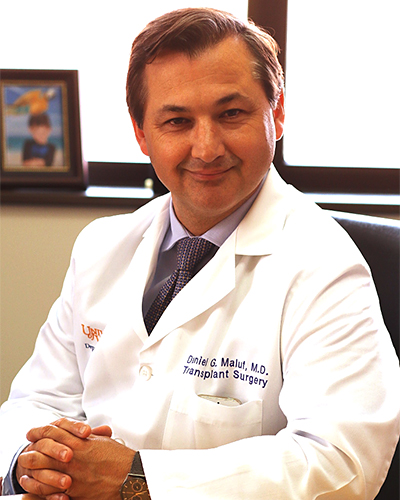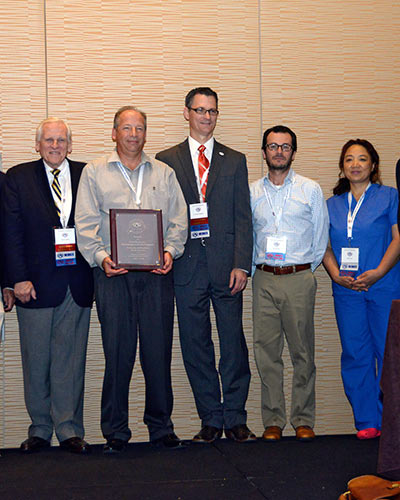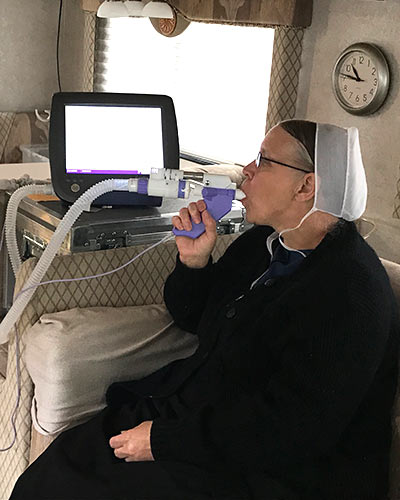November 15, 2017 | Bill Seiler

Scoring System Can be Improved to Select Best Candidates for Transplant
With a limited number of lungs available, deciding who gets a transplant can be a matter of life or death. New research from the University of Maryland School of Medicine (UMSOM) suggests that the system for choosing transplant recipients in chronic obstructive pulmonary disease (COPD) may underestimate how long a person might survive without a lung transplant and therefore, may mislead clinicians.
The score, introduced in 2004, is widely used to predict how long a person will live with COPD. Known as the BODE score, it combines Body mass index, airflow Obstruction, Dyspnea (shortness of breath) and Exercise capacity.
Researchers who developed the BODE score observed survival for patients with the most severe disease that was clearly worse than survival after a lung transplant. In time, the BODE score became a quick way to predict survival without transplant and thus to identify those patients suffering from COPD who might live longer with a transplant. “While the BODE score was and remains to be a valuable prognostication tool in COPD, it has not been validated for this particular purpose,” says lead investigator Robert M. Reed, MD, UMSOM associate professor of medicine and a pulmonary and critical care specialist at the University of Maryland Medical Center. The originator of the BODE score, Bartolome R. Celli, MD, of the Brigham and Women’s Hospital in Boston, is senior author of the current paper.
This study, published online in the journal Chest, compared survival data in the original group of 625 patients (93 percent male) who formed the basis for the BODE score to 4,300 lung transplant patients (49 percent male) who had COPD. Results suggest that the BODE score overestimates mortality risk in lung transplant candidates with COPD. This is likely due to the fact that these patients have a lower burden of other ailments such as cancer and heart disease, and are not active smokers. Patients selected as candidates for lung transplantation survive considerably longer than would be predicted by prognostic estimates extrapolated from the original BODE group.
“Our research shows that we are often transplanting people who may not actually derive a survival advantage at all, and we may be shortening the lives of some people with transplant,” says Dr. Reed.
COPD accounts for about a third of all lung transplants, but the disease progresses so slowly that patients with very severe COPD can survive without a transplant at levels comparable to those who’ve had a transplant.
“Statistically, a lung transplant is a risky thing. About half of people are dead 5-6 years after a lung transplant, due to transplant complications, so, obviously, you don’t want to transplant people who are likely to live longer if left alone,” says Dr. Reed.
The study notes that just as cardiovascular disease and cancer are major killers in the general population, they also play a major role in the deaths of COPD patients. Further, modern lung transplant screening for COPD typically determines that patients with heart disease or cancer, as well as those who have not stopped smoking, are not eligible for transplant.
The paper does not point to a newer, more accurate way to predict transplant survival in COPD patients, but Dr. Reed says the transplant community may want to look at new kinds of measurement. However, he points out that survival is only one factor, albeit a major one, in the very personal decision facing both physician and patient contemplating lung transplantation.
“Dr. Reed and his team are to be commended for shedding light on some of the issues that attend when the BODE score is used to project the survival of lung transplant candidates with COPD,” says E. Albert Reece, MD, PhD, MBA, vice president for medical affairs at the University of Maryland, the John Z. and Akiko K. Bowers Distinguished Professor and dean of UMSOM. “This study suggests it may be worthwhile to weigh the value of new standards that take into account current transplant center screening practices.”
About the University of Maryland School of Medicine
Commemorating its 210th Anniversary, the University of Maryland School of Medicine was chartered in 1807 as the first public medical school in the United States. It continues today as one of the fastest growing, top-tier biomedical research enterprises in the world -- with 43 academic departments, centers, institutes, and programs; and a faculty of more than 3,000 physicians, scientists, and allied health professionals, including members of the National Academy of Sciences, and a distinguished recipient of the Albert E. Lasker Award in Medical Research. With an operating budget of more than $1 billion, the School of Medicine works closely in partnership with the University of Maryland Medical Center and Medical System to provide research-intensive, academic and clinically-based care for more than 1.2 million patients each year. The School has over 2,500 students, residents, and fellows, and nearly $450 million in extramural funding, with more than half of its academic departments ranked in the top 20 among all public medical schools in the nation in research funding. As one of the seven professional schools that make up the University of Maryland, Baltimore campus, the School of Medicine has a total workforce of nearly 7,000 individuals. The combined School and Medical System (“University of Maryland Medicine”) has a total budget of $5 billion and an economic impact of nearly $15 billion on the state and local community. The School of Medicine faculty, which ranks as the 8th-highest public medical school in research productivity, is an innovator in translational medicine with 600 active patents and 24 start-up companies. The School works locally, nationally, and globally, with research and treatment facilities in 36 countries around the world. Visit medschool.umaryland.edu/
About the University of Maryland Medical Center
The University of Maryland Medical Center (UMMC) is comprised of two hospitals in Baltimore: an 800-bed teaching hospital – the flagship institution of the 12-hospital University of Maryland Medical System (UMMS) – and a 200-bed community teaching hospital, UMMC Midtown Campus. UMMC is a national and regional referral center for trauma, cancer care, neurocare, cardiac care, diabetes and endocrinology, women’s and children’s health, and has one of the largest solid organ transplant programs in the country. All physicians on staff at the flagship hospital are faculty physicians of the University of Maryland School of Medicine. At UMMC Midtown Campus, faculty physicians work alongside community physicians to provide patients with the highest quality care. UMMC Midtown Campus was founded in 1881 and is located one mile away from the University Campus hospital. For more information, visit www.umm.edu.
Learn More
Contact
Department of Anesthesiology
(410) 328-6120 (phone)
(410) 328-5531 (fax)
newsletter@som.umaryland.edu
University of Maryland School of Medicine
Bill Seiler
Media Relations
410-328-8919
bseiler@umm.edu
Related stories

Thursday, May 29, 2025
New Pulmonary Arterial Hypertension Treatment Offers Hope for Patients in Advanced Stage of Disease
A relatively new therapy used to treat pulmonary arterial hypertension in those with mild to moderate disease was found to be effective at preventing death in those with more advanced disease. Results were published on Wednesday, May 28, in The New England Journal of Medicine and could have “transformative implications” for patients, according to an editorial that accompanied the study written by Bradley Maron, MD, Professor of Medicine and Director of the Hypertension Program at the University of Maryland School of Medicine.

Wednesday, April 10, 2024
UMSOM Researchers Identify Safety of a Potential New Treatment to Manage Complications from Sickle Cell Disease
A drug approved to treat pulmonary arterial hypertension may be effective at managing hypertension and end-organ damage in patients with sickle cell disease, according to a new study published in Lancet Haematology. An early phase randomized clinical trial involving 130 patients with sickle cell disease found that the drug, called riociguat, was found to be safe to use and well tolerated in these patients and significantly improved their blood pressure. Preliminary efficacy data suggested the medication might improve heart function.

Monday, June 14, 2021
Study Links COVID-19 Public Health Efforts to Dramatic Drop in COPD Hospitalizations
Researchers at the University of Maryland School of Medicine (UMSOM) analyzed data at the 13-hospital University of Maryland Medical System (UMMS) and found public health measures designed to reduce the spread of the COVID-19 virus may have fostered a substantial side benefit: Hospital admissions for chronic obstructive pulmonary disease (COPD) were reduced by 53 percent, according to a new study published in The American Journal of Medicine. This is likely due to a drop in circulating seasonal respiratory viruses such as influenza.

Thursday, May 20, 2021
University of Maryland Medicine Performs Two Successful Lung Transplants on Patients with COVID-19 Lung Damage
Two patients who were near death after COVID-19 destroyed their lungs, survived and are thriving due to state-of-the-art care and double-lung transplants by University of Maryland School of Medicine (UMSOM) surgeons at the UM Medical Center (UMMC).

Tuesday, September 26, 2017
University of Maryland Medicine Receives Prestigious Award For Its Heart and Lung Resuscitation Program
A heart and lung resuscitation program at University of Maryland Medicine (UMM) has been recognized for its elite level of care by a leading group in the field.

Friday, May 05, 2017
Secondhand Smoke Ups Heart Disease in Unique Group of Female Nonsmokers – Amish Women
New research at the University of Maryland School of Medicine (UM SOM) has found that secondhand smoke tends to have somewhat different effects on men and women. The research, conducted in a Pennsylvania Amish community where virtually no women smoke, found that women who were exposed to secondhand smoke had a greater risk for cardiovascular disease, while men exposed to secondhand smoke tended to have a higher body mass index (BMI).
